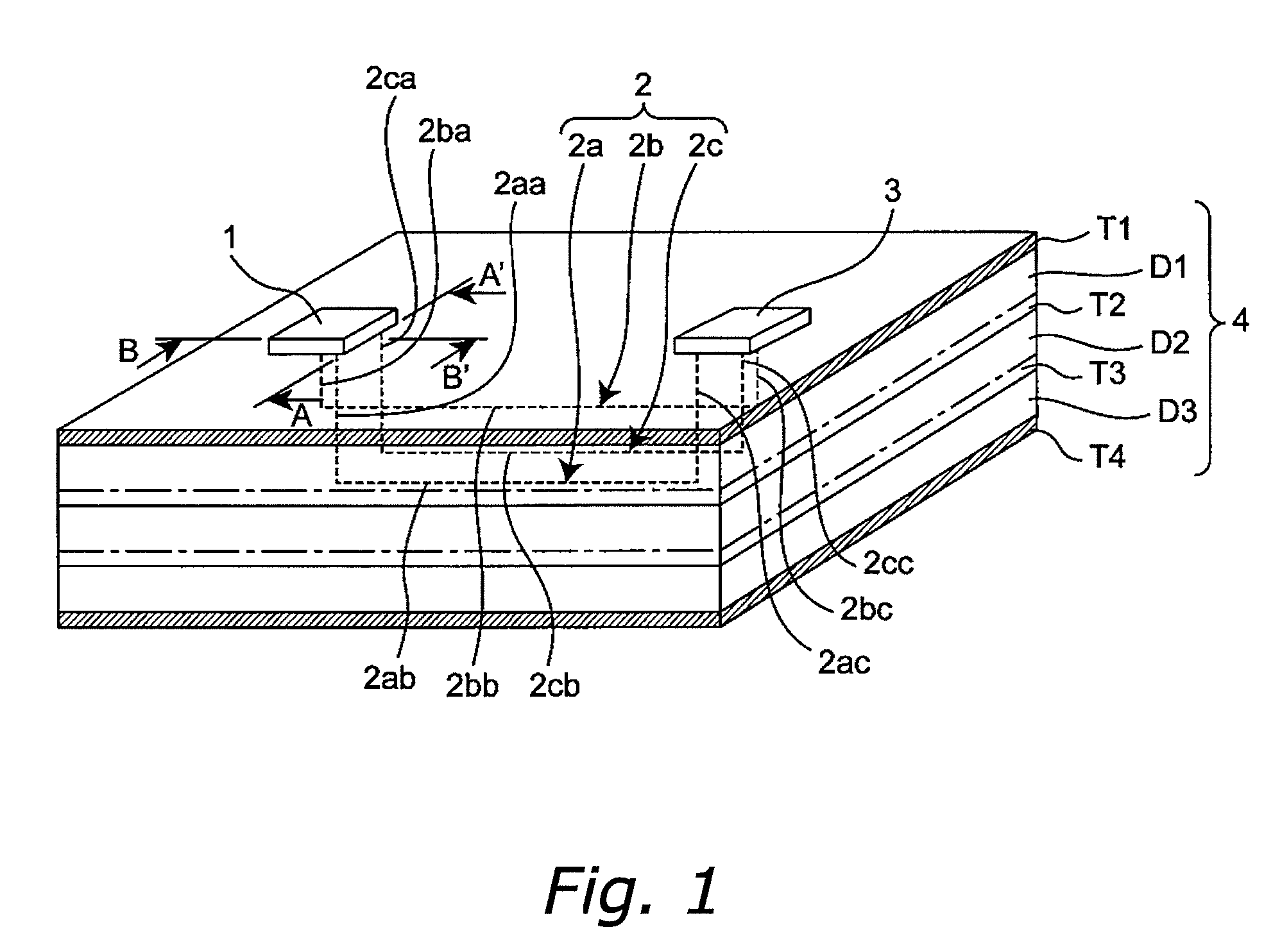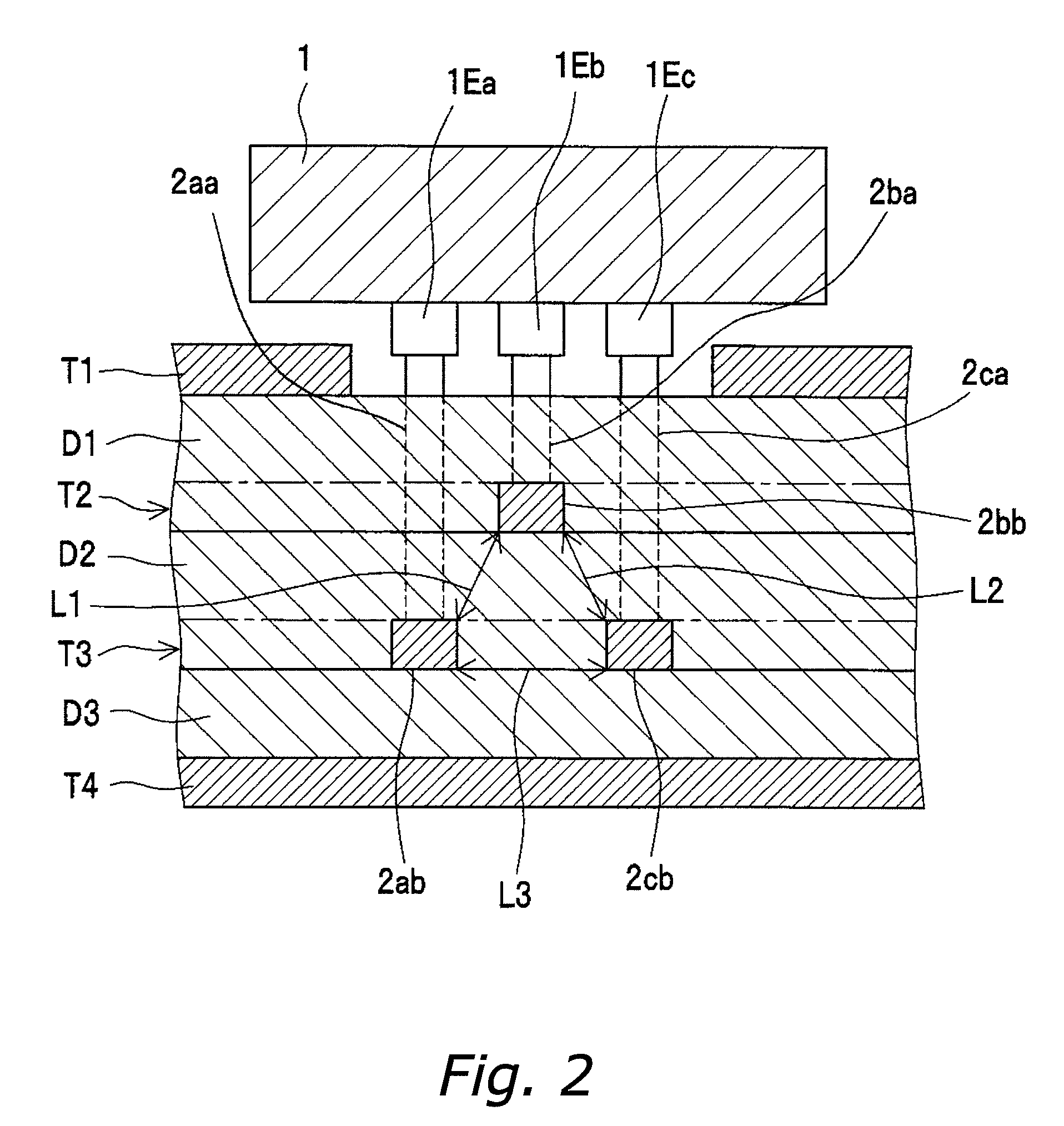Differential transmission line
a transmission line and differential technology, applied in the field of differential transmission lines, can solve the problems of increasing the wiring region of the printed circuit board, affecting the transmission speed of the signal line, so as to achieve the effect of reducing the noise of unwanted radiation
- Summary
- Abstract
- Description
- Claims
- Application Information
AI Technical Summary
Benefits of technology
Problems solved by technology
Method used
Image
Examples
first embodiment
[0094]FIG. 1 is a perspective view that shows the schematic configuration of the differential transmission circuit, with some parts transparent, according to a first embodiment of the invention, FIG. 2 is a cross-sectional view showing the section taken vertically along the line A-A′ in FIG. 1, viewed in the arrow direction, and FIG. 3 is a cross-sectional view showing the section taken vertically along the line B-B′ in FIG. 1, viewed in the arrow direction. The differential transmission line of this embodiment is a differential transmission line 2 that is provided on a printed circuit board 4, which is provided with a plurality of laminated conductor layers T1, T2, T3, and T4, and is provided with three signal lines 2a, 2b, and 2c that transmit differential signals from a differential driver IC 1 on the printed circuit board 4 to a differential receiver IC3 on the printed circuit board 4, and is characterized in that the largest portion of the signal lines 2a, 2b, and 2c resides in...
second embodiment
[0162]FIG. 5 is a perspective view that shows the schematic configuration of a differential transmission circuit, with some parts transparent, according to a second embodiment of the invention, and FIG. 6 is a top view of the differential transmission circuit of FIG. 5. In this embodiment, in order to form the signal lines 2a, 2b, and 2c at equal lengths in the signal line route length adjustment segment on the differential driver IC1A side, the signal line route length adjustment segments of signal lines 2a and 2c are provided with signal line return portions 2ad, 2ae, 2cd, and 2ce, instead of adjusting the positions of the differential signal output terminals 1Ea, 1Eb, and 1Ec of the differential driver IC1 as in the first embodiment.
[0163]The differential transmission circuit of this embodiment is provided in a double-sided printed circuit board 4A, which is provided with two conductor layers T5 and T6 and a dielectric layer D4 between these layers. L13 is the distance between th...
third embodiment
[0171]FIG. 7 is a perspective view that shows the schematic configuration of a differential transmission circuit, with some parts transparent, according to a third embodiment of the invention, and FIG. 8 is a cross-sectional view showing the section cut along the line A-A′ in FIG. 7. With the differential transmission circuit of this embodiment, three bit information signals are transmitted via a differential transmission line 2 that is made from three signal lines 2a, 2b, and 2c. It is characterized in that the three signal lines 2a, 2b, and 2c are disposed parallel to one another, and in a section perpendicular to the longitudinal direction of the differential transmission line 2, the three signal lines 2a, 2b, and 2c are disposed at substantially the same spacing on a same circumference, and thus they are located at the apexes of an equilateral triangle. Moreover, in the section perpendicular to the longitudinal direction of the differential transmission line 2, the signal lines ...
PUM
 Login to View More
Login to View More Abstract
Description
Claims
Application Information
 Login to View More
Login to View More - R&D
- Intellectual Property
- Life Sciences
- Materials
- Tech Scout
- Unparalleled Data Quality
- Higher Quality Content
- 60% Fewer Hallucinations
Browse by: Latest US Patents, China's latest patents, Technical Efficacy Thesaurus, Application Domain, Technology Topic, Popular Technical Reports.
© 2025 PatSnap. All rights reserved.Legal|Privacy policy|Modern Slavery Act Transparency Statement|Sitemap|About US| Contact US: help@patsnap.com



